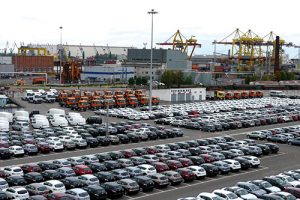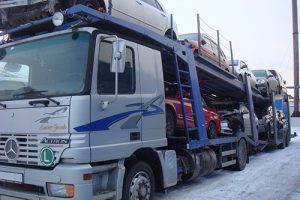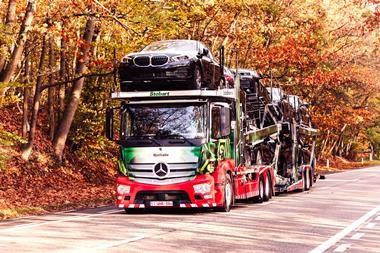 [in_this_story align="right" border="yes"]In August last year, imports of finished vehicles in Russia rose 5.3% year-on-year, bringing an end to a decline that had lasted for 35 consecutive months. Meanwhile, during the course of 2016, several carmakers, including SsangYong and Honda, unveiled plans to start importing finished vehicles into the country again after a break of almost two years. Others, including BMW, General Motors and Suzuki, are already beginning to increase imports, expanding the range of models they supply to the Russian market.
[in_this_story align="right" border="yes"]In August last year, imports of finished vehicles in Russia rose 5.3% year-on-year, bringing an end to a decline that had lasted for 35 consecutive months. Meanwhile, during the course of 2016, several carmakers, including SsangYong and Honda, unveiled plans to start importing finished vehicles into the country again after a break of almost two years. Others, including BMW, General Motors and Suzuki, are already beginning to increase imports, expanding the range of models they supply to the Russian market.
Year-on-year imports have still been falling, however several factors are slowing the decline. Across 2016, the Russian rouble was the world’s best-performing currency, strengthening 22.59% against the dollar and even more against the euro. In January this year, meanwhile, it continued to rise, gaining 3.28% against the dollar.
The resurgence of the rouble has been encouraged by signs of a recovery in Russia’s economy and by Donald Trump’s election as US president. During his election campaign, Trump promised to “restore relationships with Moscow” and “reconsider sanctions policy”. The first US sanctions on Russia were lifted in February. However, given controversy over links between certain members of the Trump administration and Russia, it is not clear how relations between the countries will develop.
Analysts from banks and analysts including Société Générale, Bloomberg and Russia’s major bank, VTB, all suggest that, coupled with stabilising global oil prices, this could help the rouble’s value rise by a further 10-[sta_anchor id="1"]20% in coming months, leaving it only slightly below pre-crisis levels. This could spur demand for imported goods in Russia, including finished vehicles – just as the collapse of the Russian rouble in 2014 contributed to a stifling of import volumes, together with economic declines and government policy.

An end to import declines?Almost all the forecasts now suggest that drops in imports of finished vehicles will cease this year, with a return to growth likely either later this year or in 2018.
Tatiana Hristova, manager for central and eastern Europe light vehicle forecasts at IHS-Markit, says she expects the share of imports in Russia’s finished vehicles sales to rise 25% by 2020, which should propel imports as well. Russia’s Trade and Industry Ministry estimated that through the first 11 months of last year, about 16% of vehicle sales to Russia were imported; full-year figures would mean imports of 220,000-225,000, far off levels seen before the recent decline, and especially the peak back in 2008, when imports represented around one-third of the market, or close to 1m vehicles per year.
According to IHS-Markit, that peak is unlikely to be seen again without significant changes in governmental import policy. “The previous level of 30% will not be achieved again, according to our base forecast scenario where we assume the same regulatory environment as right now,” states Hristova. “We expect further aggressive marketing strategies from manufacturers with domestic production, for one thing, with further brands being added to many Russian production portfolios.”
OEMs producing in Russia are already expanding their product portfolios to address the preferences of domestic car buyers, Hristova points out – in particular producing more affordable cars for everyday use, such as B-segment, smaller SUVs. Although the rouble has enjoyed a dramatic recovery of late, it hasn’t been enough to make imports that much more attractive, she adds.
Imports of finished vehicles will, however, be supported by the premium market segment where, with the exception of BMW, which uses a kit assembly plant in Kaliningrad, most brands are still imported. That’s demonstrated by the fact that despite the steep decline in imports more generally, this segment of the market saw imports fall only from 84% of overall sales in 2014 to 82% over the last two years. Plans by Mercedes-Benz to start producing passenger cars at a new site in Moscow Oblast, however, will likely see premium import levels fall sharply somewhere after 2020, IHS-Markit suggests.
 "The previous [market share level for imports] of 30% will not be achieved again... We expect further aggressive marketing strategies from manufacturers with domestic production." - Tatiana Hristova, IHS Automotive
"The previous [market share level for imports] of 30% will not be achieved again... We expect further aggressive marketing strategies from manufacturers with domestic production." - Tatiana Hristova, IHS Automotive
Alexey Volodin, head of the automotive industry and railroad transport department at Russia’s Ministry of Industry and Trade, says that this year, the government expects a 7% rise in sales of new cars compared to 2016, to 1.5m units, but that the share enjoyed by imports is expected to remain largely unchanged.
The ministry’s basic forecast suggests that in coming years, finished vehicle imports’ share of the market may even fall, even though in absolute terms import numbers would rise together with the market. By 2020, in particular, sales of finished vehicles in Russia should reach 2m units, while in 2025 the market could rise as high as 3m units. By this time, imports will account for 14% – or around 420,000 finished vehicles – nearly twice current volumes, Volodin predicts.
In the light commercial vehicle segment, the situation will be different, however, with imports accounting for just 7% of the total by 2025, he suggests.
Earlier forecasts from 2013 by the ministry for 4.5m passenger car sales in Russia by 2020 are no longer realistic, Volodin concedes.
[related_topics align="right" border="yes"]Russia’s OEMs currently have a combined capacity of 3.3m finished vehicles a year, and new assembly lines are expected in coming years, Volodin confirms. With the forecast rise in sales, many will seek to unfreeze current production capacity, making any major increase in imports’ market share unlikely.
Dmitry Vostrikov, general director of WWL’s Russian division, confirms this outlook, suggesting that volumes of vehicle imports will grow only in proportion to growth in the wider market and general economy.
“In general, the automotive industry in Russia may expect a further decline in import volumes due to growth in local production and assembly,” he says. “The Russian government has been taking action to encourage global OEMs to invest in local production facilities, and that strategy is likely to continue in coming years.”
Halina Helfand, commercial director of logistics provider Lorus SCM, also suggests imports will likely only grow in line with the Russian market, though even that may not be long lived.
“Imports will grow at the same rate as domestic sales, but only until the point where restoring previously withdrawn capacity in the country becomes feasible again. The moment greater domestic production is restored, imports will start falling again,” she says.
[sta_anchor id="2"]Some brands will use imports more than others, however. During 2016, Lorus SCM began managing imports of SsangYong cars into Russia, Helfand reveals, and while the volumes are currently small, they are expected to rise in line with overall sales in the Russian market.
Counting the variablesThe future of import volumes, however, will depend on numerous variables. These range from the obvious, such as domestic demand levels and the rouble exchange rate, to the unpredictable, such as political turbulence or sudden changes in the country’s localisation requirements.
[mpu_ad]Vostrikov believes the level of sales last year suggests the Russian car market will stabilise in 2017, and possibly even enjoy slight growth. However, he stresses that unexpected challenges could arise as a consequence of political change in certain countries, which could either boost growth further or lead to regression in the market.
Volodin remarks that, at the moment, Russia’s Ministry of Industry and Trade is working on its new strategy for automotive development in Russia for the period 2017-2025, with the bill expected to be published this spring. A key issue in this is the government’s intention to cut state support for the automotive industry.
This year, says Volodin, the government will allocate 62 billion roubles ($1 billion) to supporting OEMs, but in the next few years its support will become “more targeted”. So far, however, it has not become clear whether the government will take steps towards changing the terms of its industrial assembly agreements with carmakers, which offer preferential import duties for meeting production and localisation targets.
Experts in the country are not sure how this approach might affect vehicles sales in Russia. According to government estimates, one in three cars sold there last year benefitted from state support programmes.
“Since 2013, the import of finished vehicles in Russia has experienced a downward trend, primarily due to a general decline in car sales in the country and the implementation of programmes within the government’s resolution on industrial assembly, which allows automakers to apply for government support subject to a certain level of localisation and investment,” says Anna Komarova, head of finished vehicle logistics sales in Russia at Gefco.
[sta_anchor id="3"]Given this, Komarova predicts that serious growth in sales of imported cars cannot be expected until the expiration of the latest agreements on industrial assembly in 2018-2019. If such support is not renewed, she points out, a hike in prices for vehicles is quite possible.
Era-Glonass impactA further factor in the short term is that imports could be negatively affected by the new requirement to equip every finished vehicle in Russia with the Era-Glonass accident emergency response system, a Russian-developed telematics system. Introduced in January, this has led to a number of car shipments that were underway at the time of the legislative change being blocked on their way into the country.
 Imports are being delayed in some cases by new requirements for every finished vehicle in the country to incorporate Russia’s Era-Glonass telematics system
Imports are being delayed in some cases by new requirements for every finished vehicle in the country to incorporate Russia’s Era-Glonass telematics systemArtem Pavlikov, director of overland for east Europe at logistics provider Agility, says importers and dealers will require time to meet the new requirement, which is likely to cause delays in supply of some models during 2017. Pavlikov says there are around 700 non-compliant cars blocked at Russian customs warehouses in the Far East of the country, and this figure could rise, making it critical that enough warehouse space can be found to store them until the problem is resolved.
Russia’s Association of Automotive Dealers has estimated that the requirement to fit all vehicles with Era-Glonass will reduce the number of model ranges in Russia by 5-10%, as carmakers minimise the high costs of obtaining approval certification for each model and the cost of the extra telematics hardware. That could cause losses for the country’s automotive sector of around 30 billion roubles a year.
Falling import volumes have not, however, substantially changed the pattern of import flows into Russia. Most vehicles continue to be imported by sea via the north-west ports, including Russian Baltic ports of St Petersburg, Ust-Luga and Bronka, as well as Kotka, Finland and Paldiski, Estonia. These are followed by some ports in the south, primarily Novorossiysk, and eastern ports such as Vladivostock.
Dmitry Vostrikov of WWL confirms that the biggest share of inbound volumes from Asia, Europe and North America are imported via the Baltic, mainly St Petersburg, as reasonably developed port infrastructure makes this the most convenient option.
WWL has seen a trend towards cutting logistics costs with reduced stocks and supply levels in import logistics, he says, with some car brands changing their whole supply concept to deliver only pre-ordered vehicles to Russia. This can significantly extend lead times, he admits – in some instances by several months.
While St Petersburg is a dominant point of entry, the port of Paldiski in Estonia and the port of Kotka in Finland are also still used. Andrey Rodionov, spokesman for Mercedes-Benz Russia, says his company imports all of its passenger cars and most of its light commercial vehicles via Paldiski port in Estonia, delivering them from there into Russia by road.
WWL manages imports of Haval vehicles from China into Russia via Kotka, for instance. Vostrikov says the longer transit time via Kotka is compensated for by the freedom to store vehicles in customs warehouses in Finland indefinitely until called off by the dealer – where Russian customs legislation restricts the amount of time for which finished vehicles can stay in customs storage, limiting this as a rule to 60 days.
However, Alexander Kovalenko, national customs manager at Gefco Russia, suggests that based on the experiences of two major importers, there is no need to store finished vehicles in customs warehouses. For most market players, he says, it makes no sense to store cars for several months, at least during periods of normal turnover.
 Although most enter through Russian ports, some vehicles are imported via Finnish and Estonian ports and then moved by truck across the border into Russia
Although most enter through Russian ports, some vehicles are imported via Finnish and Estonian ports and then moved by truck across the border into Russia[sta_anchor id="4"]There are restrictions on vehicles placed in temporary storage in ports – for example, relating to diagnostics and marking – but these are not out of line with standard practice worldwide and as long as sufficient vehicle volumes are involved, Russia’s ports remain competitive, he suggests.
Russian ports gain groundIn fact, non-Russian ports have continued to lose market share to Russian ones. Andrey Novikov, deputy head of the marketing department at LLC Fenix, owner and operator of the port of Bronka, says that in 2016, transit of vehicles to Russia from Finnish ports fell significantly: Kotka, for instance, saw volumes fall 60% over the year to just 8,000 cars. The appeal of Russian Baltic ports is obvious, he says, given their proximity to the European side of the country and to Moscow.
Marina Stepina, spokeswoman for the Eurasia region at the PSA Group/Mitsubishi Motors joint venture PSMA, says that last year, the company imported 97% of its finished vehicles into Russia by sea, primarily via St Petersburg and Novorossiysk.
However, she adds that the range of imported models was reduced last year as PSA Group decided to focus primarily on those segments with the most stable demand.
Lubov Karchevskaya, a spokeswoman for Ford in Russia, says it has localised production of most of its passenger cars in the country, but from early 2017 it started importing commercial vehicles including the Transit Custom and Tourneo Custom, sending shipments from Turkey and delivering to St Petersburg by ferry.
Gefco’s Anna Komarova agrees that the main sales market for imported cars is on the European side of Russia, especially Moscow and St. Petersburg.
“So finished vehicles arriving in the north-west region and warehouses in Moscow with automotive carriers on hand have a significant advantage in terms of transit times to dealers,” she says.
Proving the point, in late 2016, LLC Fenix secured a contract with BLG Logistics for port handling services in Bronka. This deal will involve handling vehicles for Volkswagen, Audi, Porsche, Bentley, Lamborghini and Skoda. BLG has announced that it expects volumes at the terminal in 2017 to reach 60,000 units.
Novorossiysk, to the south, tends to be the port of choice for flows from Turkey and southern Europe, however, often providing efficiency-boosting backloads for trucks delivering to southern dealerships from the north, Komarova adds.
Such facilities demonstrate that Russian ports certainly have the capacity to handle more vehicle imports. However, whether or not the volumes will come remains to be seen.
 "[Russia’s vehicle imports have dropped] due to a general decline in car sales in the country and [programmes that allow OEMs] to apply for government support subject to a certain level of localisation and investment." - Anna Komarova, Gefco
"[Russia’s vehicle imports have dropped] due to a general decline in car sales in the country and [programmes that allow OEMs] to apply for government support subject to a certain level of localisation and investment." - Anna Komarova, Gefco





















